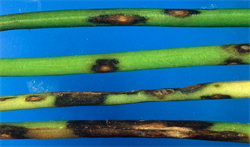- Moderately widespread. Important fungus disease of sweetpotato of Eastern and Central Africa. Recorded from PNG. Yield losses worst in cool, moist highlands, above 1500masl. At least four species described.
- Small, dark brown/black oval spots, on mature leaves, up to 5mm diameter, merging, with yellow halos and ring patterns. Veins on underside of leaves turn black. Later, leaves yellow and fall. Grey spots on stems and petioles becoming black and sunken.
- Spread: spores on the wind and in wind-driven rain. Over long distances on cuttings used for planting. Survival in soil, on plant debris.
- Biosecurity: risk from unofficial introduction of vines and storage roots. Official movement of germplasm should always follow the FAO/IPBGR Technical Guidelines.
- Biocontrol: none.
- Cultural control: select vines free from old leaves and spots; raise disease-free vines from storage roots in nurseries; weed; at harvest, collect and burn/bury old vines or compost. NASPOT varieties bred for Africa for resistance to Alternaria blight, and sweet potato virus disease. Selections and breeders’ lines available in South Africa. Chemical control: Mancozeb, copper compounds, or the mixture azoxystrobin-difenoconazole.
Pacific Pests, Pathogens and Weeds - Online edition
Pacific Pests, Pathogens, Weeds & Pesticides
Sweetpotato Alternaria blight (527)
Sweetpotato Alternaria blight. It is also known by several other names: leaf and stem blight disease, Alternaria leaf and stem blight, Alternaria anthracnose. (Using the term 'anthracnose' for this disease can be confusing. This term is usually given to fungal diseases caused by Colletotrichum species - black spots on stems, leaves and fruits that produce masses of slimy pink spores under humid conditions.)
Alternaria bataticola. Recent work using morphology and molecular sequencing in South Africa recognises several Alternaria species associated with blights on sweetpotato. Alternaria bataticola is recognised from Australia, Japan, South Africa, but so too is newly described Alternaria ipomoea (Ethiopia, South Africa), and Alternaria neoipomoea (South Africa). Another species, Alternaria argyroxiphii (South Africa), was previously described from another host.
AUTHOR Grahame Jackson
Information from Adebola PO, et al. (2010) Molecular characterisation of Alternaria species of Sweet Potato and development of a host resistance screening protocol. Aspects of Applied Biology 96:309-313. (http://www.cabi.org.ezproxy.library.uq.edu.au/cpc/FullTextPDF/2010/20103346646.pdf); Ames T, et al. (1997) Sweet potato: major pests, diseases, and nutritional disorder. International Potato Center, Lima, Peru. (http://cipotato.org/wp-content/uploads/publication%20files/books/002435.pdf); Mwanga ROM, et al. (2003) Release of six sweet potato cultivars (‘NASPOT 1’ to ‘NASPOT 6’) in Uganda. Hortscience 38(3):475-476. (http://hortsci.ashspublications.org/content/38/3/475.full.pdf); Mwanga ROM, et al. (2007) Release of two orange-fleshed sweet potato cultivars, ‘SPK004’ (‘Kakamega’) and ‘Ejumula’ in Uganda. Hortscience 42(7):1728-1730. (http://hortsci.ashspublications.org/content/38/3/475.full.pdf); Mwanga ROM, et al. (2011) ‘NASPOT 11’, a Sweet potato Cultivar bred by a Participatory Plant-breeding approach in Uganda. Hortscience 46(2):317–321. 2011.(http://hortsci.ashspublications.org/content/46/2/317.full.pdf); O’Sullivan J, et al. (Undated) Sweet potato DiagNotes: A diagnostic key and information tool for sweet potato problems. (https://keys.lucidcentral.org/keys/sweetpotato/key/Sweetpotato%20Diagnotes/Media/Html/TheProblems/DiseasesFungal/AlternariaStemBlight/Alternaria%20blight.htm); and from Woudenberg JHC et al. (2014)Large-spored Alternaria pathogens in section Porri doisentanged. Studies in Mycology 79: 1-47. (https://www.studiesinmycology.org/index.php/issue?start=12); and from Kandolo SD, et al. (2016) African Crop Science Journal 24(3): 331-339. https://www.ajol.info/index.php/acsj/issue/view/14556
Produced with support from the Australian Centre for International Agricultural Research under project HORT/2016/185: Responding to emerging pest and disease threats to horticulture in the Pacific islands, implemented by the University of Queensland, in association with the Pacific Community.





